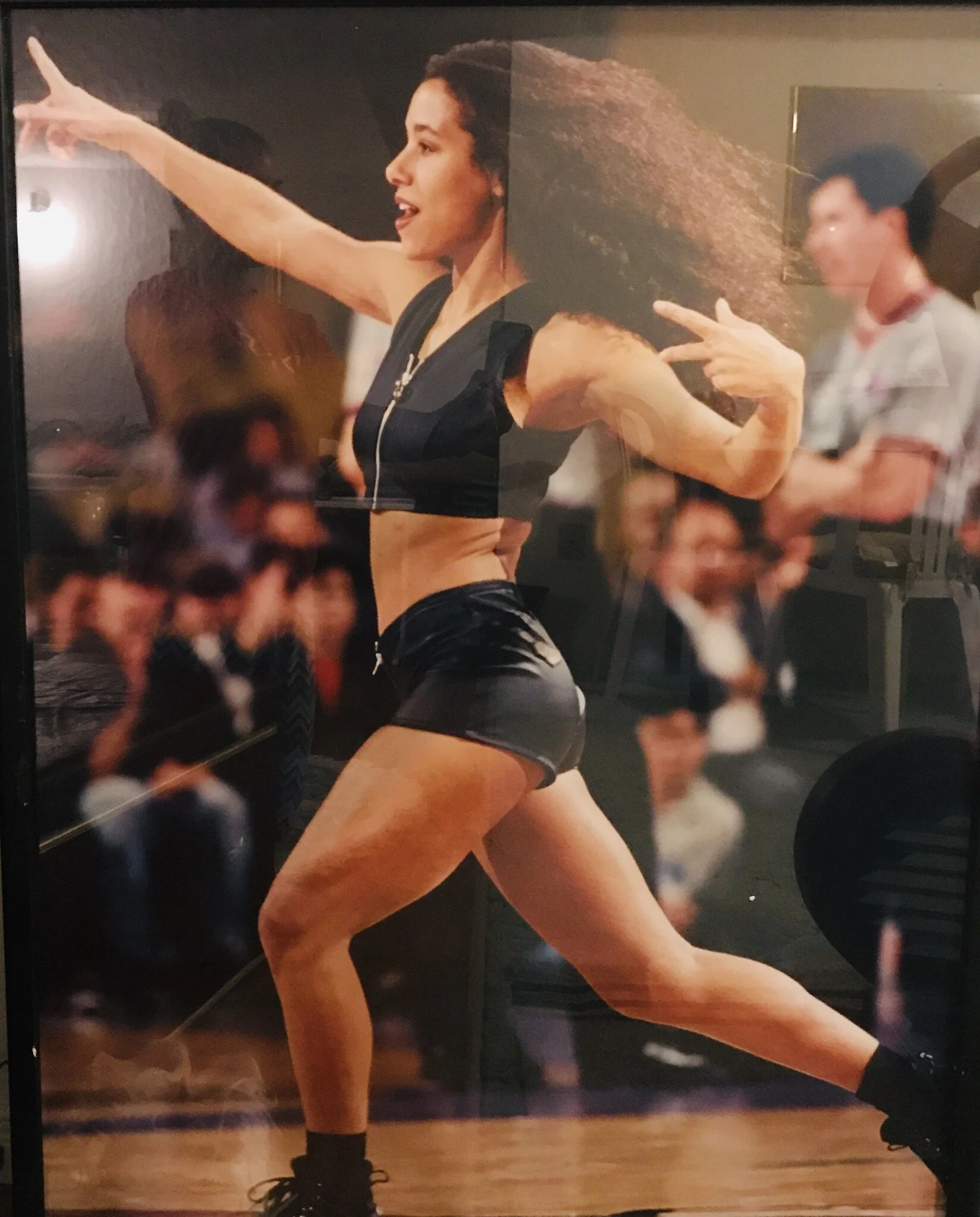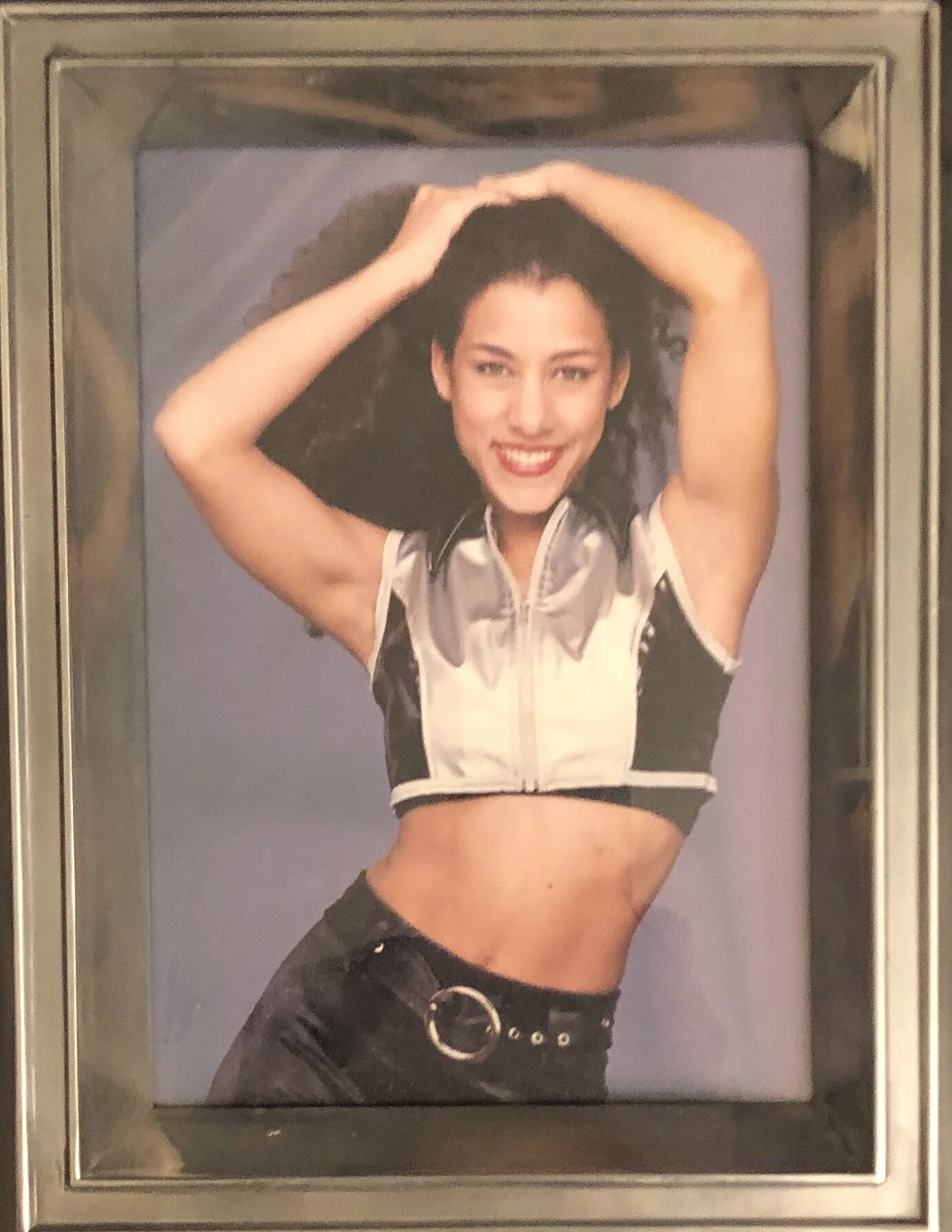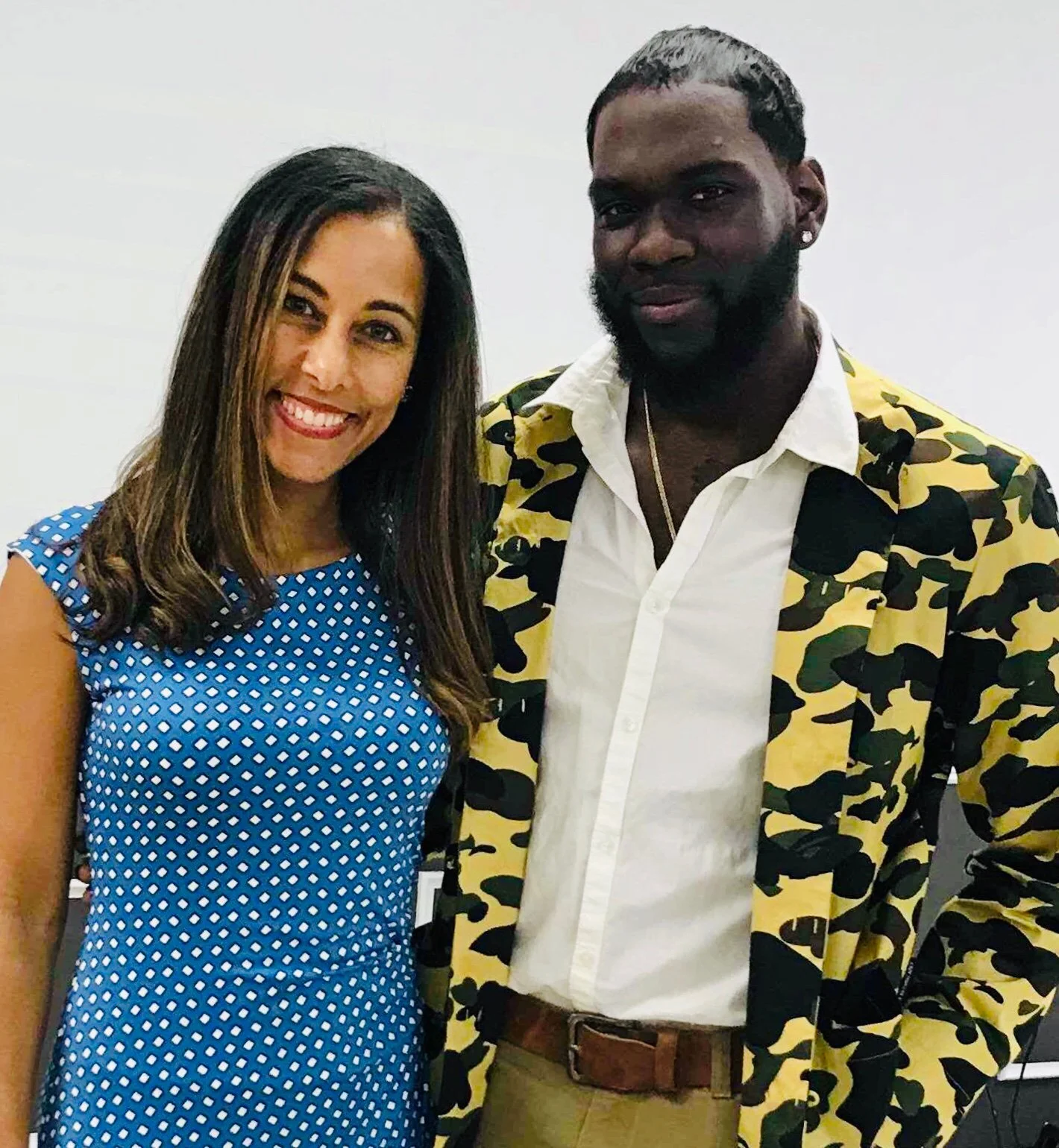Tamara Mose…From dancer to university professor
June 16, 2020
Pretty face, svelte body, catchy moves.
As the first leader of the Toronto Raptors cheerleading dancers, Tamara Mose possessed the entire package and was excited to be given the opportunity to deliver for the new Canadian National Basketball Association (NBA) franchise.
Doing the first dance team newspaper ad even before getting the job, she recruited, choreographed and was part of the team that oversaw the hiring of food concessionaires.
Tamara Mose was in the dance team’s first newspaper ad
In her fourth season, Mose felt she could add more value to the organization beyond entertaining. Her application for a front-office job was, however, turned down.
That didn’t sit well with her.
“I strongly felt like people could only see me as a dancer,” said Mose who dropped out of Seneca College Fashion Merchandising program after a year. “In my mind, I knew I had to get more education.”
Tamara Mose in action during a Raptors game
Tired of performing with her body, she left the Raptors at the end of the 1999-2000 season to prepare to use her mind to perform.
“I thought to myself what a perfect opportunity to do something different,” Mose, who was born and raised in Guelph, said. “I had always wanted to go back to college to see if it would be different as I was older. It didn’t quite work out for me the first time around when I was 17 and so I wanted to challenge myself in a different way.”
With her then husband accepting a job offer in the United States, the couple moved to Los Angeles and Mose returned to the classroom.
Armed with Associate Arts and undergraduate degrees, Mose applied to a PhD program.
While patiently waiting for a reply, she accepted a Master’s degree offer at the University of California Los Angeles prior to the City University of New York Graduate Centre responding with an offer to enter their PhD Sociology program in 2003.
Breezing through undergraduate school, she quickly learned that pursuing a doctorate is a different kettle of fish.
“Going back to school and getting my undergraduate degree was easy, but I soon realized that doing a PhD was really hard because there were so many smart people in my class,” the community college class valedictorian said. “But what was great about grad school is that I could study whatever I wanted to. Once you do all your course work, you can do your dissertation on whatever topic you choose. I had already known in my undergraduate work that I wanted to study Caribbean people, but I didn’t know in what way I wanted to do that.”
In her first year in graduate school, Mose had a baby and started to go nearby parks where she observed Black women caring for White babies.
“I thought what is this phenomenon I am seeing and then as I started to hear the familiar accents, I recognized that they were all women from different Caribbean countries,” she said. “I started talking to them informally and asking certain questions. I then inquired if I could write about them and they agreed.”
Capturing the women’s stories over three years led to Mose’s dissertation and first book, ‘Raising Brooklyn: Nannies, Childcare and Caribbeans Creating Community’, that provides a detailed look at the daily lives of the childcare providers and examines the important roles they play in the families whose children they help raise.
Her second book, ‘Playdate: Parents, Children and the New Expectations of Play’, published in 2016 provides a first-hand account of the strategies used by middle-class parents of young children to navigate social relationships.
It is based on interviews conducted with parents, teachers, childcare directors and nannies from Brooklyn, Manhattan, Queen’s and Long Island.
Mose is currently engaged in research on food and sex for her third book that looks at professional women in urban centres.
“I wanted to learn more about their relationship to food and sex,” she said. “It’s not that they necessarily intersect in any way, but I wanted to see what Black professional women experiences have been with both because we hear a lot about food and sex among low-income folks and in ways that don’t reflect necessarily professional Black women which is a voice I wanted to be heard.”
Considering choreography and academia to be creative endeavours made Mose’s transition smooth.
“I was just performing different material in front of a different audience,” she noted. “That’s how I feel about teaching and when I present my research in front of audiences at conferences and so on. I feel like I am just performing something different in front of different people.”
After her first year at Seneca, Mose went to Los Angeles to visit older sister and 1995 Emmy Award winner Charonne Mose who was auditioning for a Fly Girl dance role in ‘In Living Colour’.
Tamara (r) & Charonne Mose
While sitting outside watching performers enter the performing area, she caught the attention of choreographer Rosie Perez who invited her to audition.
Out of about 500 dancers, the Mose sisters emerged as the two finalists and the younger sibling got a call two weeks later saying she had got the job. She was, however, unable to accept the offer because American dancers objected to a Canadian securing the role and her work permit application was refused.
Back in Toronto three months later, she taught dance and performed before learning that an NBA team was coming to Toronto.
As a young girl growing up in southwestern Ontario, Mose gravitated to boxing as her father, University of Guelph Professor Emeritus and former University of the West Indies (UWI) lecturer Dr. Kenrick Mose who settled in Canada in 1969, embraced the ‘Sweet Science’.
It didn’t matter that three-time world heavyweight boxing champion Lennox Lewis was her favourite sports personality and she wasn’t a hoops fan.
“All I knew was that a new team was coming and basketball teams have dancers,” she said. “At the time, I was dating someone who had created a logo for the Raptors. When told they couldn’t take anything outside their network and so on, I got turned back to him and I said not only would they need that type of creativity, but they would need something on court.”
Mose suggested he submit her routine reel from ‘In Living Colour’ and resume.
The Raptors liked what they saw and hired her as their first co-ordinator and choreographer.
The first order of business was to recruit dancers.
The inaugural audition at the Westin Harbour Castle Hotel attracted hundreds of applicants.
“It was like every dancer in Toronto and the outskirts wanted to be part of this new team,” the then 21-year-old recalled. “I choreographed a routine and then had some dancers show those who were auditioning that routine. People just came in groups and we had to select from there. I was very conscious of what I was looking for and the biggest thing for me was I wanted to represent Toronto in its entirety. That meant having diversity in terms of ethnicity and race”
The diversity extended to gender as the Raptors was the first NBA organization to recruit male dancers.
“There was some push back at times because of how the corporate world operates, but they pretty much give me free rein in terms of selection and so on,” she said. “Once I made my pitch for this is what Toronto represents, it was great. It was beautiful to see that kind of mélange with the dance team.”
Tamara Mose was one of the Raptors most important hires
Soon after being hired, Mose was flown out to New York to have a look at the Knicks dancers.
“They wanted to emulate what it is they did or, to at least, see what another version of this looks like,” she said in the recently released OG 25th Reunion video. “When I saw those dancers, they were clearly doing a hybrid of jazz and hip hop. I had been doing and teaching hip hop, so many of my routines stemmed from my teaching or just playing the music.”
Vanessa Cobham, who spent four years with the Raptors Dance Pak, said Mose was the perfect fit for the role.
“Though Tamara was just 21 at the time and still young, I think the experience she gained in the United States along with her exceptional talent and drive were the deciding factors in her getting hired as the co-ordinator,” she said.
Tamara Mose (stooping second from left) with the inaugural Raptors Dance Pak members
Longtime Raptors broadcaster Paul Jones said former part owner and Executive Vice-President Isiah Thomas singled out Mose, public address announcer Herbie Kuhn and the mascot as the most important hires to launch the franchise.
“Isiah needed something to keep the attention on the team at times when they weren’t playing well,” he said. “She had been on a prominent show (In Living Colour) and I thought she did a great job the first couple of years as our dance crew was one of the best in the NBA.”
Jones isn’t surprised Mose transitioned to the education field.
“She always came across as a very smart person and someone who is in touch with current events,” he added.
Mose isn’t the only former Raptors dancer who is in academia.
Theresa Runstedtler, who grew up in Kitchener, graduated from York University and worked as a professional dancer, model and actress, completed her PhD in History at Yale University in 2007 and is an Associate Professor at American University.
Taught some basic boxing skills and artistic skipping by 1990 Commonwealth Games gold medallist Chris Johnson who moved to Kitchener from Jamaica at age eight, she authored ‘Jack Johnson, Rebel Sojourner: Boxing in the Shadow of the Global Colour Line’ that started as a dissertation and was extended into a comprehensive account of Johnson’s reign as the first Black world heavyweight champion and his struggle to find a home.
“We met up a couple years at a conference I was at in Baltimore and that was the first time we had seen each other in many years,” said Mose whose late uncle, Arnold Thomasos, was the longest serving Speaker of the Trinidad & Tobago House of Parliament. “It was really nice just to hear how each of us was dealing with the tenure clock. That was a totally different conversation than we would have had 25 years ago. It was so good to see her and talk about something completely different and realize how much we actually have in common in terms of academic work because she also studies race and ethnicity just like I do.”
Forrmer Raptors dancers-turned-university professors Tamara Mose (l) & Theresa Runstedtler
Though a New York resident for almost 17 years, don’t expect to see Mose supporting the Brooklyn Nets or New York Knicks.
“Once a Raptor, always a Raptor,” she said with a big laugh. “People thought I was crazy until a year ago when Toronto won the championship which was quite an experience watching from my living room. It was so nice to see what could develop from something that you were part of from the beginning. I felt a sense of pride seeing them achieve that goal because I had a hand in this company at some point, and probably the most crucial point in the first five years. There was a lot of effort that went into the creation of the franchise.”
Tamara Mose will always be a Raptors supporter
A Professor at Brooklyn College since 2008 and the Director of the Mellon Mays Undergraduate Fellowship for the last three years, Mose encourages her students to explore their creative side while pursuing an academic interest.
“I recall my father always writing Poetry which he published with his academic work, my older sister was a dancer and we always had music in the house,” she said. “I have two cousins who are ballet dancers at The Julliard School in New York. We have a family that’s very mixed with academics and the creative arts. There was never anything in me saying it was either or. It was just about pursuing what you are passionate about which is what I did and I was fortunate to have opportunities where I could actually pursue both fully.”
The cousin of Canadian painter and Rutgers University Associate Professor Denyse Thomasos who died suddenly in New York eight years ago, Mose attributes her success to the support and flexibility of her selfless parents who migrated from Trinidad & Tobago.
Charmion Mose was a Library Associate at the University of Guelph where her husband specialized in Spanish and Latin American Studies.
“It was an expectation of you to get an education, having Caribbean parents who focus a lot on getting an education,” she pointed out. “But I think what was different about my parents being from the Caribbean was that they were really open and I have my sister (Charonne) to thank for this because she paved the way in terms of our family having a dancer or choreographer. My parents were open to us exploring that creative side and even if they didn’t quite agree with it in their minds, I never felt held back because of my creative side.”
Mose has also had the support of Western University Professor Emeritus Anton Allahar who spent his first 20 years in Trinidad & Tobago before migrating to Canada in 1969. He is her father’s brother-in-law.
When she was the Director of Caribbean Studies at Brooklyn College, he went to the campus to help her launch a revamped major as a dual major.
“He gave two lectures which were amazing,” recounted Mose who has three children ages 15, 14 and six. “The funny thing is I didn’t now I have an uncle in Sociology until I got my degree in Sociology and became a Professor. It was amazing to read his academic work and then to actually be able to speak with him about his work in the community at large in terms of academia and to have him come and participate in an event I threw at Brooklyn College. It was really special to have him there.”
Tamara Mose with Sociology student Kimani Joseph who died last year
The United States resident for the last 20 years hasn’t ruled out the possibility of returning home to live and work.
“It’s always been something at the back of my mind,” Mose, whose eldest sister Deborah Mose is an elementary teacher with the Wellington Catholic District School Board, pointed out. “I have always said if the University of Toronto ever offered me my dream job, I might just bolt and come back home.”
And what is that dream job?
“It would be a full Professor position in the Sociology department and teaching the things I love to teach like Race & Ethnicity, Qualitative Research Methods or even Caribbean Diaspora and Social Theory,” she added.














